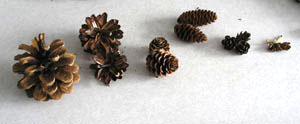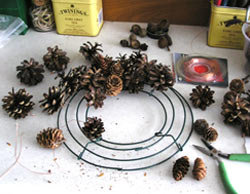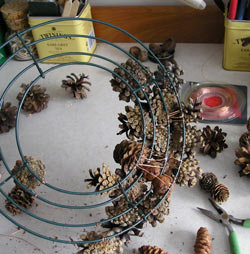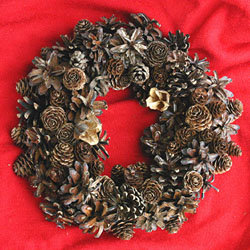My wreaths begin in the late summer when the cones drop. I pick up red pine cones down along the cedar break and while I?m there, pick some of the tiny white cedar cones. I wander down to the fence line at the bottom of the little orchard and pick the Japanese larch cones that swing on the lower branches. I harvest hemlock cones in the swampy little wood on Stan?s brother?s land and red spruce cones down by our little creek. I add them to my growing collection kept in old laundry baskets and cardboard boxes and wait.
In late October, I start getting out the wire wreath forms and looking for my packets of copper wire. My fine needle nose plyers are in a box on the counter in the backroom, unless someone has “borrowed” them. I sort out some of the older cones, stirring gently through the growing collection. When November’s clouds turn to December snows, I begin.
My wreaths are organic in nature. I never go in with a plan, but let the cones lead me. Occasionally, I will use only one variety of cone as in the all larch cone wreath at the beginning of this article, but more often than not, the wreaths are made up of all the varieties that I have. The cones that I choose to use most often are smaller cones, red pine, larch and red spruce with eastern hemlock and white cedar cones to fill in tiny spaces. I like the smaller cones because they give me a nicely filled in wreath and I find them easy to work with.

Virginia pine, red pine, Japanese larch, red spruce, hemlock, white cedar
I use wire forms and attach the cones using 24 guage copper wire. This gives a stronger, longer lasting wreath. When I get to the end of wiring on the cones, I do occasionally use a glue gun to attach the finer hemlock and cedar cones, dried seed heads and flowers, although I often just stuff them in the spaces.

I begin by cutting the copper wire into half a dozen 5 inch to 7 inch lengths. Some of the smaller cones don’t need them nearly that long, but I adjust as I go along. The first cones are easy to wire, but as the wreath becomes fuller, the wiring becomes trickier. I use small needle nose plyers, the finer the tip the better, for working in between the wire form and the other cones. I keep the cones pushed tightly together as I go along. Holding the wreath up to a a window will tell you where you may need to fill in or tighten the spacing.

When I find that I can't fit any more cones into the wreath, I go to my collection of dried seed heads and flowers. I often use daylily seed heads and Siberian iris seed heads, multiflora or pasture rose hips and dried roses, statice and strawflowers. When I've decided that I can't fit one more thing in, I attache a wrapped wire hanger to the back of the wreath. This is often unnecessary, but gives whosoever should get to hang it a sense of direction.

The trees mentioned in this article are:
Virginia Pine Pinus virginiana
Red Pine Pinus resinosa
Red Spruce Picea rubens
Eastern Hemlock Tsuga canadensis
Japanese Larch Larix kaempferi
special thanks to Melody Rose for the photo of the final product.
(Editor's Note: This article was originally published on December 1, 2007. Your comments are welcome, but please be aware that authors of previously published articles may not be able to promptly respond to new questions or comments.)









